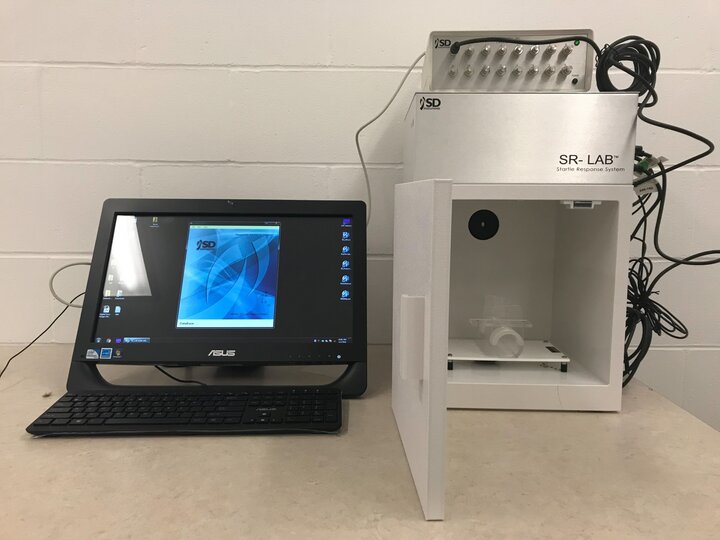The SR-LABTM Startle Response System is the world's most widely used system for startle reflex measurement and by far the most successful for fear-potentiated startle and pre-pulse inhibition testing. The startle response is comprised of a constellation of reflexes elicited by sudden, relatively intense stimuli. The startle reflex is useful for studying fundamental properties of nervous function ranging from neurophysiological and anatomical relationships within the pons and reticular formation to forebrain regulation of complex behavioral states and cognitive processes. Prepulse inhibition (PPI) is a neurological phenomenon in which a weaker pre-stimulus (prepulse) inhibits the reaction of an organism to a subsequent strong startling stimulus (pulse). The stimuli are usually acoustic, but tactile stimuli (e.g. via air puffs onto the skin) and light stimuli are also used. The SR-LAB System can be used to test the startle habituation and pre-pulse Inhibition paradigms with no additional kits required.

Workflow
A. After placing the animal in the test chambers allow a 5-min adaptation period before the start of the session.
B. Background white noise (65 dB) is present during this adaptation period and throughout the session. The session starts with four 120 dB, 40 msec sound bursts. These are not included in the analysis because the responses to the first few startle bursts generally differ in magnitude from the rest of the trials. Thus, exposure to these initial bursts allows for the establishment of a stable baseline.
C. Following this, acoustic startle trials are initiated. For simple assessment of acoustic startle responses, use two or three stimulus intensities (90 and 105 dB or 90, 105, and 120 dB). The stimuli are 40 msec in duration and are presented in a quasi random order so that an equal number of presentations of each stimulus intensity is included in each half of the session, and no single intensity is presented more than two times in succession.
D. The time between stimuli averages 15 sec but this interval should be varied within a range of 5–30 sec so that the animals do not anticipate the stimulus. At least 10 trials at each stimulus intensity should be used to obtain reliable results.
E. An alternative to evaluating the magnitude of the startle response is to measure the startle threshold. Here, a wider range of stimulus intensities, e.g., from 70 to 120 dB, is used. Stimuli are presented in quasi-random order, and the lowest intensity producing a reliable response is determined. Since some habituation of the response can occur both within a session and between sessions (see below), trials at each intensity should always be evenly distributed within a session (but they should not, of course, be presented in a predictable sequence).
F. Startle Habituation
- a) This measure is of interest in the area of schizophrenia research, since schizophrenics show impaired startle habituation, an impairment that may be related to the hypervigilance characteristic of this condition.
- b) For startle habituation, a single stimulus intensity is repeatedly presented using either a fixed or variable interval. Responses normally decline (habituate) over trials.
- c) In this case, each session is initiated with a 10-min acclimation period followed by 121 successive 120 dB, 40 msec trials separated by a fixed inter-trial interval (ITI) of 10 sec. The first trial is excluded from analysis due to variability. Each block has 20 trials. Two groups of CD1 mice received ip injection of water and MK-801 at 0.3 mg/kg, respectively, 15 min before the test. Startle habituation is displayed by the water-treated group but not by the MK-801-treated group. Long-term habituation of the startle response can also be used as a memory index by conducting a second session at a later time (e.g., 24 hr later) and assessing long-term retention of habituation.
G. Pre-pulse Inhibition
- a) In this version of the test, the attenuation produced by a low intensity stimulus presented just before the startle stimulus is assessed. We sometimes assess PPI on the day following standard startle testing. This serves to habituate the animals to the basic handling procedures and, in the case of pharmacological studies of PPI, allows groups to be matched for baseline startle, as well as elimination of animals that either startle excessively or do not respond.
- b) The animals are given a 5-min acclimation period in the startle chambers during which a 65-dB background noise is presented. This background noise remains throughout the entire test. Following the 5-min acclimation period, four successive trials of 40-msec noise bursts at 120 dB are presented.
- c) These trials are not included in data analysis. Subjects are then exposed to five different types of acoustic stimuli in a randomized order: pulse alone (120-dB noise for 40 msec), no stimulus (no stimulus is presented), and three separate prepulse + pulse combinations, with prepulse set at three sound levels of 70, 75, and 80 dB for 20 msec followed by a 40-msec pulse at 120 dB. There are 100 msec between the prepulse and the pulse.
- d) A total number of 12 trials under each acoustic stimulus condition are presented with average 20-sec variable intervals ranging from 5 sec to 25 sec. The inclusion of four pulse-alone trials in the beginning of the experiments is to help normalize the response of the mice, as there is rapid habituation to the startle responses seen within the first few trials.
- e) More than one level of prepulse intensity is used, whereas a “no stimulus” trial is used to assess the influence of background movement on startle measures.
- f)To reduce variability, at least 12 trials of each type should be conducted within a single session. As with standard startle testing, trial types and ITIs should be presented in a quasi-random, balanced manner with equal representations of trial types and intervals in each half of the session. This allows the session to be analyzed in two blocks to assess any changes over time.